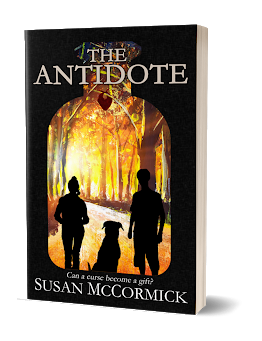Can a curse become a gift?
 SEATTLE – Longtime physician and successful mystery author Susan McCormick is back with a new novel sure to enchant readers of all ages. “The Antidote” (May 5, 2021, The Wild Rose Press) is her first foray into middle grade fantasy, though readers will be left hoping it won’t be her last.
SEATTLE – Longtime physician and successful mystery author Susan McCormick is back with a new novel sure to enchant readers of all ages. “The Antidote” (May 5, 2021, The Wild Rose Press) is her first foray into middle grade fantasy, though readers will be left hoping it won’t be her last.
Twelve-year-old Alex Revelstoke can see disease. And not just disease — injury, illness, anything wrong with the body. A gift that comes in handy when a classmate chokes on a hot dog or when the janitor suffers a heart attack unclogging a gooey science experiment gone awry.
But Alex soon learns his new ability puts him and an unsuspecting world in peril. Throughout time, Revelstokes have waged a battle against ancient evil itself — the creator of disease. Alex has seen its darkness. He has felt its strength. He does not want to fight. But Alex is the last Revelstoke. The war has just begun.
With her unique perspective as a doctor, mother and writer, McCormick combines her knowledge of medicine and her storytelling skills to craft a one-of-a-kind adventure about disease, darkness and deception — one readers won’t be able to put down.
“The Antidote”
Susan McCormick | May 2021 | The Wild Rose Press | Middle Grade Fantasy / Historical Fiction
Paperback | 978-1-5092-3566-7 | $16.99 | Ebook | 978-1-5092-3567-4 | $4.99

SUSAN McCORMICK is a writer and doctor who lives in Seattle. She graduated from Smith College and George Washington University School of Medicine and served as a doctor for nine years in the U.S. Army before moving to the Pacific Northwest and civilian practice. In addition to “The Antidote,” she writes a cozy murder mystery series, “The Fog Ladies.” She also wrote “Granny Can’t Remember Me,” a lighthearted picture book about Alzheimer’s disease and dementia. She is married with two boys, neither of whom have any special powers. She loves giant dogs and has had St. Bernards, an English Mastiff, Earl, and two Newfoundlands, Edward and Albert. None of them had any special powers, either, except the ability to shake drool onto the ceiling. Visit her at https://susanmccormickbooks.com.
Follow Susan McCormick on social media
Facebook: @susanmccormickauthor | Twitter: @SMcCormickBooks
Instagram: @susanmccormickbooks | Bookbub: @susan-mccormick
In an interview, Susan McCormick can discuss:
- How her children’s love of Rick Riordan’s books inspired her to write a middle grade novel
- Integrating science and medicine into an adventure story to engage students and make learning fun
- Providing readers with a historical framework to understand the relationship between humans and infectious disease
- The novel’s sudden timeliness during the pandemic and how COVID-19 upended the book’s own release
- Writing across multiple genres — from cozies to fantasy to picture book — and how she incorporates her perspective as a doctor into all her work
- The amazing talents animals have at detecting disease
An interview with Susan McCormick
1. What made you decide to write a book catered toward a middle grade audience but focusing on disease and health?
When I volunteered in my oldest son’s middle school, I was struck by how much mythology the kids knew — everything there was to know and then some. They studied it in school, but they already knew it through the Percy Jackson books by Rick Riordan. During a science class chicken wing dissection meant to teach about tendons, muscles and bones, I realized the kids didn’t know nearly as much about the human body. As a doctor and mother, I wanted to impart an enthusiasm of the human body and a knowledge of disease and health much like the kids had for mythology. The importance of this is even greater in the era of COVID-19.
2. Did you come across anything interesting or surprising during your research while writing the book?
Something fun I learned during research for the book was the extra gifts animals have, extraordinary senses, etc., that have been harnessed to help people. For instance, dogs (and cats) have the ability to detect diseases and dangers of all kinds: cancer, low blood sugar, an impending seizure, infectious diseases, bombs, etc. In the book, the giant dog, Valentine, can detect cancer.
3. You are a very busy person! How do you find time to write?
As a doctor and a mom, time was always in short supply. In Seattle in the summer, the sun rises at 4:30 a.m., shining bright light into my bedroom and waking me up. I would write in these early morning hours on the weekends before my family woke up. My giant, black, fluffy, silent Newfoundland dog, Albert, would dutifully pad downstairs with me and lie by my side as my constant writing companion.
4. What advice do you have for budding writers?
When I was young, I wanted to be a ballerina, a doctor and a writer. All together, all at once. My ballet days ended before they began when my first performance’s curtsy took out the backdrop and crashed it to the floor. All that was left was being a doctor and a writer. The latter took me a while. Being a doctor was a straight shot: four years of medical school, three years of internal medicine residency, then fellowship, then pay back the military with a stint in the Army because they paid for medical school, and voila, doctor.
Being a writer took longer, but I’ve been plotting my stories since those ballerina days. In elementary school, I was chosen to attend a Young Authors’ Conference, with workshops and local authors. The conference was on a Saturday. I was so excited that I dreamed God allowed me to skip Friday. I woke up on Friday convinced it was Saturday, and I grew more and more desperate when my parents told me I had to go to school. I was certain I was going to miss the conference. That’s how excited I was. But, sadly, excitement isn’t enough to turn a dream into a reality. That part took sitting in a chair every day, putting my fingers on the keyboard and writing. Do the work. Show up on time, with enthusiasm. Keep it up. Persevere. Maybe if I’d done that with dancing, I’d be a ballerina today, too.
5. What do you hope readers gain from the book?
“The Antidote” is full of illnesses kids may have encountered in their life, through family, friends or media, like heart attacks, appendicitis and allergic reactions. The story also explains infectious diseases of the past, like plague, polio, smallpox, Spanish flu, measles, leprosy, etc., which kids come across in school and history and have gained crucial relevance today with COVID-19. These diseases are woven throughout the story and I hope will spark interest in learning more about the body and medicine. At heart, though, “The Antidote” is an adventure, with good vs. evil, and I want kids to just have fun.

A former award-winning journalist with national exposure, Marissa now oversees the day-to-day operation of the Books Forward author branding and book marketing firm, along with our indie publishing support sister company Books Fluent.
Born and bred in Louisiana, currently living in New Orleans, she has lived and developed a strong base for our company and authors in Chicago and Nashville. Her journalism work has appeared in USA Today, National Geographic and other major publications. She is now interviewed by media on best practices for book marketing.

